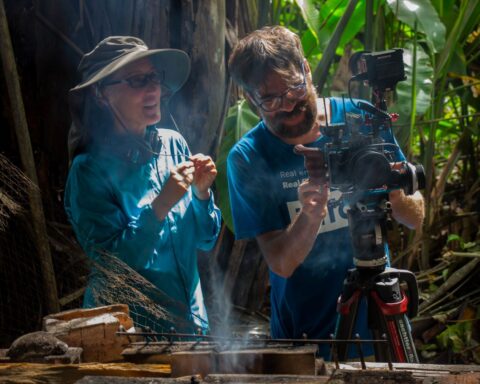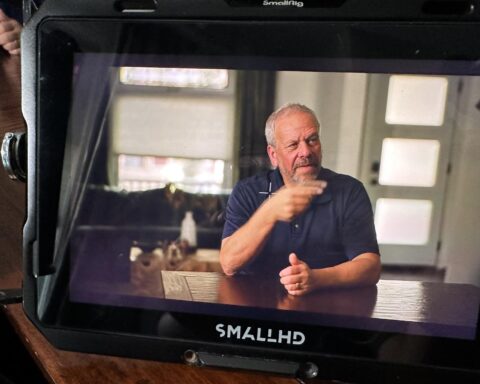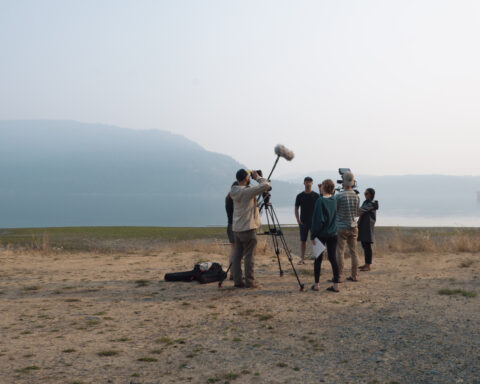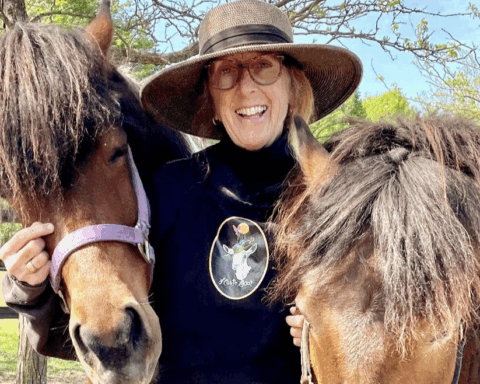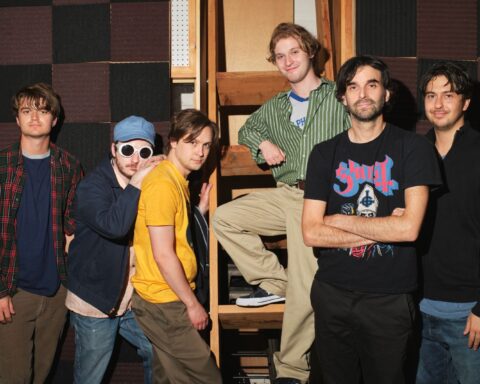I’M GOING TO HEAVEN because I just survived the road of hell.
For three hours, we’ve have been bouncing like balls in an arcade game within this silver 4×4 that’s crawling through the Sierra Leonean bush. Our driver, a grey-haired man reeking of body odour and wearing a furry sash over one shoulder like Fred Flintstone, navigates the car around the condo-sized potholes that line the road. Despite driving 10 miles per hour, Fred plunges the 4×4 into them anyway. Like bobblehead dolls, the skulls of my co-director Ngardy “Gad” Conteh George and our DP Colin Akoon are smashing into me as they “sleep” in the backseat. In contrast, I grip a handle above my window but my head keeps pounding the ceiling as the car jostles while The Beatles scream “It Won’t Be Long” through my iPod earbuds.
And then the village appears.
We’re going to film the bogeyman in Gad’s ancestral village of Mattru for some b-roll. Sierra Leoneans call their trickster-devil the gongoli, but for us he’s a symbol of duplicity, a theme that’ll emerge in our documentary, The Flying Stars. The road taking us to the gongoli is a narrow, dirt trail that nobody has maintained for more than 40 rainy seasons. Surrounded by overgrown grass, palm trees and giant insects, the road has witnessed civil war where child soldiers hacked off the limbs of other children, but the road has also attracted refugees fleeing those same rebels. We’re here to tell the stories of those amputees. Some of them play organized soccer so they can find brotherhood and promote national peace in postwar Sierra Leone.
What we discovered, like what would lie in Mattru, was something different.
“That’s a film.” It’s four years earlier, in 2008 in Toronto, where I catch a group slideshow with a friend. Suddenly, among the wanky, artsy stuff, portraits of one-legged Africans burst on screen, shot by New York photographer Fiona Aboud. Her handheld video shows these amputees racing down a soccer pitch like lightning. Jesus, I think, they run faster than me, and I have both legs. Never again would I feel self-pity or fear, because these guys overcame. These amputees halfway around the world in a place I never heard of made me want to become a better person and be part of a film about them.
Unfortunately, few shared that feeling until three years later when Gad and I stood before a live audience at 2011 TIFF and asked, “Do you believe a one-legged man can fly?” Some people did, because we won the Telefilm Pitch This competition (the only documentary ever to do so). Sundance believed, too, and granted us funding and fellowships. After nearly giving up, we finally had enough cash to film these Sierra Leonean amputees journeying to the Amputee World Cup. Roosters crow at 6:30 sharp every morning in Freetown, the overcrowded capital of Sierra Leone. The air smells of sickly sweet gasoline as portable generators sputter in every direction. Gridlocked traffic kicks up African red dirt as women carry everything from washing to luggage atop their perfectly balanced heads.
Gad, Colin plus our trusted fixer, Hashmiyun “Hash” Magona, are about to film the captain of the amputees, Bornor Kargbo. Perfect for a documentary, Bornor is a fiery, charismatic man and a natural leader. Proudly wearing the blue-green-white colours of his country around his head, Bornor has led his team to tournaments across Africa and Europe. This morning, he’s going to feed his family by bumming change around a bustling street market.
“Ready, Colin?” Gad asks our DP, who’s mounting an old Panasonic HD cam upon a 40-lb Steadicam jacket. We have 30 minutes of filming before Colin dehydrates in the 47°C humidity. It is 10 a.m. “Okay…rolling,” he says.
Bornor blazes onto a boulevard teeming with cars, pedestrians and stalls. “I’m not working, and you are my main man,” he beseeches a soft drink vendor. “Can you lend me 2,000 leones [50 cents] so I can find something to eat?” Bornor’s delivery is direct, but sympathetic. The vendor peels a few bills out of his pocket. “Oh, me manager!” Bornor high-fives the merchant. The money is enough to fill one of his children’s bellies with fish and palm oil on rice.
Somehow, Colin succeeds in keeping Bornor in frame while I clutch a 15-ft boom pole. But suddenly Bornor disappears into an alcove beneath street level and vanishes into some homes. Where the hell is he? Bornor is so agile on his crutches that it’s like chasing a rabbit.
Meanwhile, curious shoppers and kids gather around us, and there’s no way to stop them from getting in the shot. Swivelling a camera attached to a metal jacket, Colin looks like a futuristic astronaut. I’m clutching a pole high above the street like carrying a giant crucifix through St. Peter’s Square at Easter. Everybody sees us. In the west, nobody would care about a tiny documentary crew. Here, we are a freak show. “Reality TV hasn’t hit Sierra Leone,” Gad deadpans.
Making matters worse is that Colin (who is Asian-white) and I (Chinese descent) already stand out, and the camera equipment turns us into targets of scorn. “Fuck you,” the merchants peddling rice and fish curse us in their native Krio. Sierra Leoneans accuse foreign journalists and filmmakers of interviewing them for stories that they believe make these greedy westerners filthy rich. What they don’t realize is the high cost to fly here with 150 pounds of AV equipment, buy visas and insurance, rent hotels and cars, pump vaccinations into our arms and bribe plainclothes cops. (Yes, bribes. There are no location fees in Africa, just cash handshakes.)
Bornor emerges and skips across two lanes of traffic and by the time we catch up to him, he’s playing a pick-up game of soccer, here in a country where Chelsea and Manchester United are revered. Then, he continues to beg. Sadly, most amputees in this country beg. Anywhere from 5,000 to 25,000 youngsters were amputated in the civil war between 1991 and 2002. During filming, the youngest victim we interviewed was eight, but luckily he doesn’t remember how it happened. It’s as if his psyche slammed the door to that memory so that he could endure. Most others weren’t so lucky.
A goalie on the amputee soccer team was amputated at age 15. Rebels rounded him and several boys into a house. “Little boy, come, come, come with that axe,” beckoned the leader that night. They forced his right hand down and chopped it off. “They left me bleeding,” he recalls, “just dead bodies around me.” He lay there all night and the memory haunts him to this day.
“He has not accepted himself being an amputee,” says his able-bodied brother and the team coach, aptly named Moses. “He still needs a lot of counselling…to accept that is how he will live for the rest of his life. He has never forgiven the people who did that to him.” No one in Sierra Leone has heard of PTSD (post-traumatic stress disorder), though the country is full of sufferers. The most counselling such victims receive is at churches, where they can at least unburden their pain to sympathetic pastors.
“They’re 40 to 50 years behind in healthcare,” notes Jerry Staples, a retired Seattle medical lab technician who was volunteering for Greatest Goal Ministries (GGM) when we were filming. GGM is an American non-profit sponsoring Bornor’s amputee soccer team and operating a clinic to aid amputees. “There are so many primary-care facilities that literally don’t have Band-Aids,” says Jerry, never mind PTSD counsellors.
Gradually, we ask more questions about the trauma the amputee soccer players are suffering and less about the Amputee World Cup. It doesn’t look like Bornor’s team will make it to the world tourney as they have in the past (money being one reason). So, we shed the process doc and try another angle.
It’s six p.m., magic hour in Freetown. The oppressive heat of the long day is waning and the teeming city begins to mellow as folks drift home from work and school. I look through the car window and see a flock of birds sweeping across the darkening sky. “Are those the bats?” I rhetorically ask out loud. Like the CN Tower to Toronto, the giant, two-century-old Cotton Tree in the city centre is Freetown’s symbol. It stands for freedom, christened by American slaves who founded the city in 1792. It is a stunning landmark, but it’s also home to hundreds of bats. At night, the bats abandon the tree, soar above the capital and shriek at a hideous pitch. The bats remind me that behind beauty lies something sinister.
Another day of filming: We had just left Bornor’s house on Leicester Peak nestled on the outskirts of Freetown. His home rests on a hillside offering a stunning view of the surrounding mountains. (A Portuguese explorer named the country Sierra Leone after its “lion mountains.”) “I love him, because he is fine,” Manoir confesses to our camera a few hours earlier. Manoir blushes like a schoolgirl. Behind her sits the house that their four children share. There, Bornor and Manoir cook for their young children and appear genuinely harmonious.
However, Bornor wasn’t so lucky with his first wife. She left him for an able-bodied man. “All day and night I was crying,” he tearfully recounted, “because there was no way I could breastfeed my children.” During the next two shoots over the following year, we interviewed Manoir alone and peeled back the onion. We asked her about Bornor’s war trauma. “When he compares himself with friends who have both legs and he has only one,” she reveals, “he’s not happy.” He changed after his amputation, she says. That’s most apparent every spring. “He can’t sit still. He just cries and cries all night long. His leg actually starts twitching and pulsating.”
When Bornor’s “anniversary pain” strikes, it inflames the “phantom pain” in his left stump. “I feel it right in my heart,” he explains by showing how his amputated leg trembles uncontrollably.
I get the feeling that nobody ever asked him about his “accident.” “Something happened to me April 28, 1994, at half-past one,” he says. He recounts his amputation and produces a grisly photo of his operation. His amputated leg looks like a bloody piece of meat dangling off a bone. “I can forgive,” he says with a tinge of bitterness, “but I will never forget.”
AS I FLEW OUT of Toronto’s Pearson Airport to Freetown for the first time, I jotted in a coiled pocket notebook, “Today is the sum of all your past decisions.” I don’t know why I wrote that, but it made sense long after we finished filming and were spending many months sculpting the film from the mountain of footage we had accumulated.
A documentarian doesn’t know if he’s got a film when he’s shooting it. It’s a riddle that is unlocked only through exploration and editing. During the fourth and final shoot, Moses told me off-camera, “There are things about Sierra Leone that you will not understand but must accept.” I wrote in my notebook, “The more we dig deeper into the players’ lives, the more secrets they impart that feel strange to me.”
I discovered through this long, torturous process called documentary filmmaking that the one-legged men I so admired in 2008 had feet of clay. They carried their own burdens and had their own flaws. The gongoli was actually the war trauma that possessed Bornor and his teammates. “Everybody has his own pain in different ways,” says Bornor.
BACK ON THE ROAD OF HELL, we arrived in Mattru, but after arguing with a local dance troupe and a band of musicians over payment—and nearly passing out from sunstroke—we finally filmed the gongoli dancer.
We drove three hours on the Worst Road in Africa and bickered over cash to film something that in the end we didn’t use.
It was nearing four in Mattru and getting dangerously late. It took three hours to drive to the nearest city (the distance between Toronto and Hamilton), and the sun sets exactly at 6:30 in equatorial Sierra Leone. From here to the nearest town, there are no lights, no road markings, no nothing on the road. Just a dusty path slicing through the tall African bush. If we got stuck, we were fucked.
We raced along the potholed road as fast as we could to escape getting trapped in pitch darkness teeming with insects and snakes in 38°C humidity. Our fixer, the ever-reliable Hash, revealed matter-of-factly that he had hidden in the bush just like this during the war and survived. He was lucky. He was never found and amputated. I wondered if such a holocaust could happen again to this country. Sadly, I think it could.
We made it back to town just as night fell and enjoyed dinner. Two days later, the driver informed us that all the jostling from the potholes disconnected the battery cable from the engine and we were lucky we didn’t stall that night in the bush.




